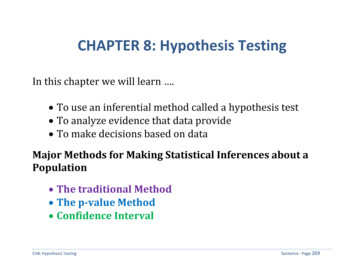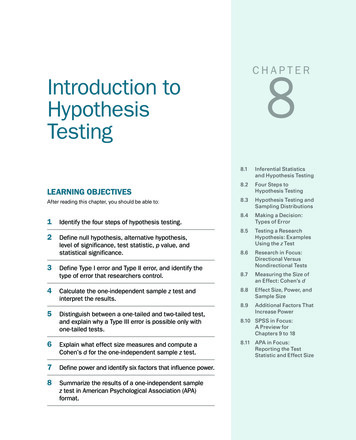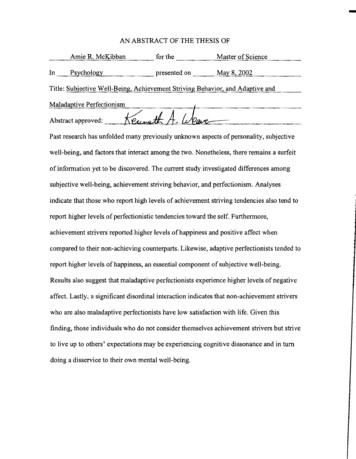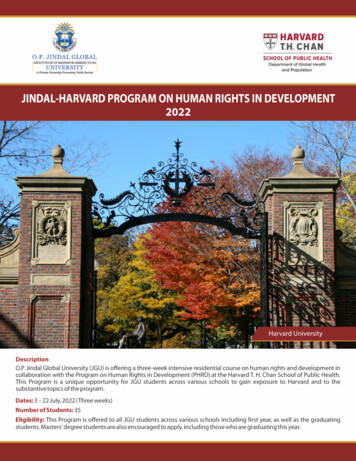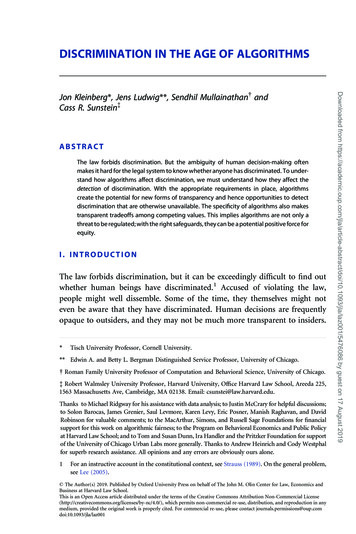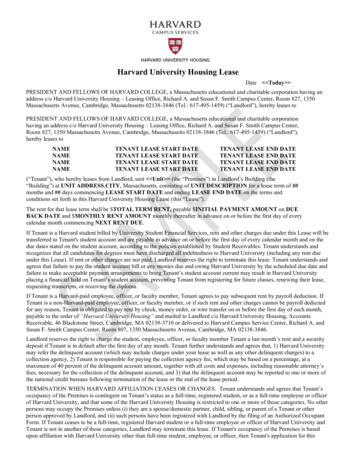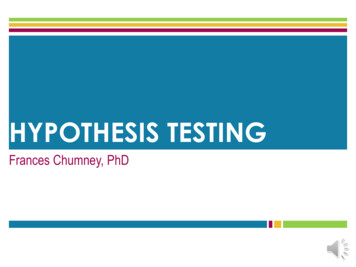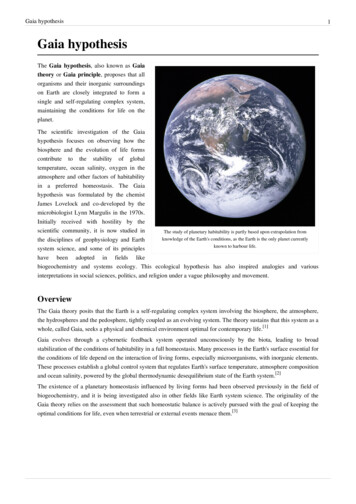
Transcription
Gaia hypothesisGaia hypothesisThe Gaia hypothesis, also known as Gaiatheory or Gaia principle, proposes that allorganisms and their inorganic surroundingson Earth are closely integrated to form asingle and self-regulating complex system,maintaining the conditions for life on theplanet.The scientific investigation of the Gaiahypothesis focuses on observing how thebiosphere and the evolution of life formscontribute to the stability of globaltemperature, ocean salinity, oxygen in theatmosphere and other factors of habitabilityin a preferred homeostasis. The Gaiahypothesis was formulated by the chemistJames Lovelock and co-developed by themicrobiologist Lynn Margulis in the 1970s.Initially received with hostility by thescientific community, it is now studied inThe study of planetary habitability is partly based upon extrapolation fromknowledge of the Earth's conditions, as the Earth is the only planet currentlythe disciplines of geophysiology and Earthknown to harbour life.system science, and some of its principleshave been adopted in fields likebiogeochemistry and systems ecology. This ecological hypothesis has also inspired analogies and variousinterpretations in social sciences, politics, and religion under a vague philosophy and movement.OverviewThe Gaia theory posits that the Earth is a self-regulating complex system involving the biosphere, the atmosphere,the hydrospheres and the pedosphere, tightly coupled as an evolving system. The theory sustains that this system as awhole, called Gaia, seeks a physical and chemical environment optimal for contemporary life.[1]Gaia evolves through a cybernetic feedback system operated unconsciously by the biota, leading to broadstabilization of the conditions of habitability in a full homeostasis. Many processes in the Earth's surface essential forthe conditions of life depend on the interaction of living forms, especially microorganisms, with inorganic elements.These processes establish a global control system that regulates Earth's surface temperature, atmosphere compositionand ocean salinity, powered by the global thermodynamic desequilibrium state of the Earth system.[2]The existence of a planetary homeostasis influenced by living forms had been observed previously in the field ofbiogeochemistry, and it is being investigated also in other fields like Earth system science. The originality of theGaia theory relies on the assessment that such homeostatic balance is actively pursued with the goal of keeping theoptimal conditions for life, even when terrestrial or external events menace them.[3]1
Gaia hypothesisRegulation of the salinity in the oceansOcean salinity has been constant at about 3.4% for a very long time.[4] Salinity stability in oceanic environments isimportant as most cells require a rather constant salinity and do not generally tolerate values above 5%. Oceansalinity constancy was a long-standing mystery, because river salts should have raised the ocean salinity much higherthan observed. Recently it was suggested[5] that salinity may also be strongly influenced by seawater circulationthrough hot basaltic rocks, and emerging as hot water vents on mid-ocean ridges. However, the composition ofseawater is far from equilibrium, and it is difficult to explain this fact without the influence of organic processes.One suggested explanation lies in the formation of salt plains throughout Earth's history. It is hypothesised that theseare created by bacteria colonies that fix ions and heavy metals during life processes.Regulation of oxygen in the atmosphereThe atmospheric composition remains fairly constantproviding the ideal conditions for contemporary life.All the atmospheric gases other than noble gasespresent in the atmosphere are either made by organismsor processed by them. The Gaia theory states that theEarth's atmospheric composition is kept at adynamically steady state by the presence of life.[6]The stability of the atmosphere in Earth is not aconsequence of chemical equilibrium like in planetswithout life. Oxygen is the second most reactiveelement after fluorine, and should combine with gasesLevels of gases in the atmosphere in 420,000 years of ice core dataand minerals of the Earth's atmosphere and crust.from Vostok, Antarctica research station. Current period is at the left.Traces of methane (at an amount of 100,000 tonnesproduced per annum)[7] should not exist, as methane is combustible in an oxygen atmosphere.Dry air in the atmosphere of Earth contains roughly (by volume) 78.09% nitrogen, 20.95% oxygen, 0.93% argon,0.039% carbon dioxide, and small amounts of other gases including methane. While air content and atmosphericpressure varies at different layers, air suitable for the survival of terrestrial plants and terrestrial animals is currentlyknown only to be found in Earth's troposphere and artificial atmospheres. Oxygen is a crucial element for the life oforganisms, who require it at stable concentrations.Regulation of the global surface temperatureSince life started on Earth, the energyprovided by the Sun has increased by25% to 30%;[8] however, the surfacetemperature of the planet has remainedwithin the levels of habitability,reaching quite regular low and gensproduced elevated levels of methane inthe early atmosphere, giving a viewsimilar to that found in petrochemicalsmog, similar in some respects to the atmosphere on Titan.[9] This, he suggests tended to screen out ultraviolet untilthe formation of the ozone screen, maintaining a degree of homeostasis. The Snowball Earth[10] research, as a result2
Gaia hypothesis3of "oxygen shocks" and reduced methane levels, that led during the Huronian, Sturtian and Marinoan/Varanger IceAges the world to very nearly become a solid "snowball" contradicts the Gaia hypothesis somewhat, although theending of these Cryogenian periods through bio-geophysiological processes accords well with Lovelock's theory.Processing of the greenhouse gas CO2, explained below, plays a critical role in the maintenance of the Earthtemperature within the limits of habitability.The CLAW hypothesis, inspired by the Gaia theory, proposes a feedback loop that operates between oceanecosystems and the Earth's climate.[11] The hypothesis specifically proposes that particular phytoplankton thatproduce dimethyl sulfide are responsive to variations in climate forcing, and that these responses lead to a negativefeedback loop that acts to stabilise the temperature of the Earth's atmosphere.Currently this Gaian homeostatic balance is being pushed by the increase of human population and the impact oftheir activities to the environment. The multiplication of greenhouse gases may cause a turn of Gaia's negativefeedbacks into homeostatic positive feedback. According to Lovelock, this could bring an accelerated globalwarming and mass human mortality.[12]Daisyworld simulationsJames Lovelock and Andrew Watson developed the mathematicalmodel Daisyworld, that shows how temperature regulation can arisefrom organisms interacting with their environment. The purpose of themodel is to demonstrate that feedback mechanisms can evolve from theactions or activities of self-interested organisms, rather than throughclassic group selection mechanisms.[13]Daisyworld examines the energy budget of a planet populated by twodifferent types of plants, black daisies and white daisies. The colour ofthe daisies influences the albedo of the planet such that black daisiesabsorb light and warm the planet, while white daisies reflect light andcool the planet. Competition between the daisies (based ontemperature-effects on growth rates) leads to a balance of populationsthat tends to favour a planetary temperature close to the optimum fordaisy growth.Plots from a standard black & white DaisyWorldsimulation.Biodiversity and stability of ecosystemsThe importance of the large number of species in an ecosystem, led to two sets of views about the role played bybiodiversity in the stability of ecosystems in Gaia theory. In one school of thought labelled the "species redundancy"hypothesis, proposed by Australian ecologist Brian Walker, most species are seen as having little contributionoverall in the stability, comparable to the passengers in an aeroplane who play little role in its successful flight. Thehypothesis leads to the conclusion that only a few key species are necessary for a healthy ecosystem. The"rivet-popper" hypothesis put forth by Paul R. Ehrlich and his wife Anne H. Ehrlich, compares each species formingpart of an ecosystem as a rivet on the aeroplane (represented by the ecosystem). The progressive loss of speciesmirrors the progressive loss of rivets from the plane, weakening it till it is no longer sustainable and crashes.[14]Later extensions of the Daisyworld simulation which included rabbits, foxes and other species, led to a surprisingfinding that the larger the number of species, the greater the improving effects on the entire planet (i.e., thetemperature regulation was improved). It also showed that the system was robust and stable even when perturbed.
Gaia hypothesisDaisyworld simulations where environmental changes were stable gradually became less diverse over time; incontrast gentle perturbations led to bursts of species richness. These findings lent support to the idea that biodiversityis valuable.[15]This finding was later proved in a eleven-year old study of the factors species composition, dynamics and diversityin successional and native grasslands in Minnesota by David Tilman and John A. Downing wherein they discoveredthat "primary productivity in more diverse plant communities is more resistant to, and recovers more fully from, amajor drought." They go on to add "Our results support the diversity stability hypothesis but not the alternativehypothesis that most species are functionally redundant."[14] [16]Processing of CO2Gaia scientists see the participation of living organisms in the Carbon cycle as one of the complex processes thatmaintain conditions suitable for life. The only significant natural source of atmospheric carbon dioxide (CO2) isvolcanic activity, while the only significant removal is through the precipitation of carbonate rocks.[17] Carbonprecipitation, solution and fixation are influenced by the bacteria and plant roots in soils, where they improvegaseous circulation, or in coral reefs, where calcium carbonate is deposited as a solid on the sea floor. Calciumcarbonate is used by living organisms to manufacture carbonaceous tests and shells. Once dead, the living organisms'shells fall to the bottom of the oceans where they generate deposits of chalk and limestone.One of these organisms is Emiliania huxleyi, an abundant coccolithophore algae which also has a role in theformation of clouds.[18] CO2 excess is compensated by an increase of coccolithophoride life, increasing the amountof CO2 locked in the ocean floor. Coccolithophorides increase the cloud cover, hence control the surfacetemperature, help cool the whole planet and favor precipitations necessary for terrestrial plants. Lately theatmospheric CO2 concentration has increased and there is some evidence that concentrations of ocean algal bloomsare also increasing.[19]Lichen and other organisms accelerate the weathering of rocks in the surface, while the decomposition of rocks alsohappens faster in the soil, thanks to the activity of roots, fungi, bacteria and subterranean animals. The flow ofcarbon dioxide from the atmosphere to the soil is therefore regulated with the help of living beings. When CO2 levelsrise in the atmosphere the temperature increases and plants grow. This growth brings higher consumption of CO2 bythe plants, who process it into the soil, removing it from the atmosphere.From hypothesis to theoryJames Lovelock called his first proposal the Gaia hypothesis. but the term established nowadays is Gaia theory.Lovelock explains that the initial formulation was based on observation, but still lacked a scientific explanation. TheGaia Hypothesis has since been supported by a number of scientific experiments[20] and provided a number of usefulpredictions,[21] and hence is properly referred to as the Gaia theory. In fact, wider research proved the originalhypothesis wrong, in the sense that it is not life alone but the whole Earth system that does the regulating.[1]In 2001, a thousand scientists at the European Geophysical Union meeting signed the Declaration of Amsterdam,starting with the statement "The Earth System behaves as a single, self-regulating system with physical, chemical,biological, and human components."[22] In 2005 the Ecological Society of America invited Lovelock to join theirFellowship, and in 2006 the Geological Society of London awarded Lovelock with the Wollaston Medal for his workon the Gaia theory.Nowadays the Gaia theory is being researched further, mainly in the multidisciplinary fields of Earth system scienceand biogeochemistry.[23] [24] It is also being applied increasingly to studies of climate change.[25]4
Gaia hypothesis5Predictions, tests and results relevant to the Gaia theory. Source: James Lovelock [26]PredictionTestResultMars is lifeless (1988)Atmospheric compositional evidence showslack of disequilibriumStrong confirmation, Vikingmission 1975Biogenic gases transfer elements from ocean to land (1971)Search for oceanic sources of dimethylsulphide and methyl iodideFound 1973Climate regulation through biologically enhanced rock weathering Analysis of ice-core data linking temperature(1973)and CO2 abundanceConfirmed 2008, by Zeebe andCaldeiraGaia is aged and is not far from the end of its development (1982)Calculation based on generally accepted solarevolutionGenerally acceptedClimate regulation through cloud albedo control linked to algalgas emissions (1987)Many tests have been made but the excess ofpollution interferesProbable for southernhemisphereOxygen has not varied by more than 5 percent from 21 percent for Ice-core and sedimentary analysisthe past 200 million years (1974)Confirmed for up to 1 millionyears agoBoreal and tropical forests are part of global climate regulationModels and direct observationGenerally acceptedBiodiversity a necessary part of climate regulationBy models but not yet in the naturalecosystemsJury still outThe current interglacial is an example of systems failure in aphysiological sense (1994)By models onlyUndecidedThe biological transfer of selenium from the ocean to the land asdimethyl selenideDirect measurementsConfirmed 2000, LissCriticismAfter initially being largely ignored by most scientists, (from 1969 until 1977), thereafter for a period, the initialGaia hypothesis was ridiculed by a number of scientists, such as Ford Doolittle, Richard Dawkins and Stephen JayGould.[27] Lovelock has said that by naming his theory after a Greek goddess, championed by many nonscientists,[28] the Gaia hypothesis was derided as some kind of neo-Pagan New Age religion. Many scientists inparticular also criticised the approach taken in his popular book "Gaia, a New look at Life on Earth" for beingteleological; a belief that all things have a predetermined purpose. Responding to this assertion in 1990, Lovelockstated "Nowhere in our writings do we express the idea that planetary self-regulation is purposeful, or involvesforesight or planning by the biota."Stephen Jay Gould criticised Gaia as merely a metaphorical description of Earth processes.[29] He wanted to knowthe actual mechanisms by which self-regulating homeostasis was regulated. David Abram argued that Gould wasunaware that mechanism was itself only metaphorical.[30] Lovelock argues that no one mechanism is responsible,that the connections between the various known mechanisms may never be known, that this is accepted in otherfields of biology and ecology as a matter of course, and that specific hostility is reserved for his own theory for otherreasons.[31]Aside from clarifying his language and understanding of what is meant by a life form, Lovelock himself ascribesmost of the criticism to a lack of understanding of non-linear mathematics by his critics, and a linearizing form ofgreedy reductionism in which all events have to be immediately ascribed to specific causes before the fact. He notesalso that his theory suggests experiments in many different fields, but few of them in biology, which most of hiscritics are trained in. "I'm a general practitioner in a world where there's nothing but specialists. science in the lasttwo centuries has tended to be ever-dividing" and often rivalrous, especially for funding, which Lovelock describesas overly abundant and overly focused on institutions rather than original thought. He points out that RichardFeynman not only shared this opinion (coining the term cargo cult science) but also accepted a lack of general cause
Gaia hypothesisand effect explanation as an inevitable phase in a theory's development, and believed that some self-regulatingphenomena may not be explainable at all mathematically.[31]The Earth aliveThe concept of a living Earth has caused a lot of controversy, partly due to the different attributes and connotationsgiven to this hypothetical life, partly because of the straightforward language used by Lovelock in his writings. Forinstance, evolutionary biologists such as the late palaeontologist Stephen Jay Gould and the ethologist RichardDawkins attacked his statement in the first paragraph of his book (1979), that "the quest for Gaia is an attempt to findthe largest living creature on Earth."[32] James Lovelock sustains that agreeing on a rational answer is not possiblebecause science has not yet formulated a full definition of life.[33]A basic criterion of the empirical definition of a life-form is its birth out of natural selection and its ability toreplicate and pass on its genetic information to a succeeding generation.[34] Dawkins stressed that, consequently, anargument against the idea that Gaia as a living organism is the fact that the planet is not the offspring of any parentsand is unable to reproduce.[18]Lovelock, however, defines life as a self-preserving, self-similar system of feedback loops like Humberto Maturana'sautopoiesis; as a self-similar system, life could be a cell as well as an organ embedded into a larger organism as wellas an individual in a larger inter-dependent social context. The biggest context of interacting inter-dependent livingentities is the Earth. The problematic empirical definition is getting "fuzzy on the edges": Why are highly specializedbacteria, such as E. coli, unable to thrive outside their habitat considered "life", while mitochondria, which haveevolved independently from the rest of the cell, are not?William Irwin Thompson suggests that the Chilean biologist Humberto Maturana and James Lovelock, with thedeductive definition of autopoiesis, have provided an explanation for the phenomenon of life.[35] Reproductionbecomes optional: bee swarms reproduce, while the biosphere has no need to. Lovelock himself states in the originalGaia book that even that is not true; given the possibilities, the biosphere may multiply in the future by colonizingother planets, as humankind may be the primer by which Gaia will reproduce. Humanity's exploration of space, itsinterest in colonizing and even terraforming other planets, lends some plausibility to the idea that Gaia might ineffect be able to reproduce.Natural selection and evolutionLovelock accepts a process of systemic Darwinian evolution for such biological feedback mechanisms: creatures thatimprove their environment for their survival do better than those that damage their environment. However, somescientists dispute the existence of such mechanisms. In 1981, W. Ford Doolittle, in the CoEvolution Quarterly article"Is Nature Motherly" argued that nothing in the genome of individual organisms could provide the feedbackmechanisms Gaia theory proposed, and therefore the Gaia hypothesis was an unscientific theory of a maternal typewithout any explanatory mechanism. In Richard Dawkins' 1982 book, The Extended Phenotype, he argued thatorganisms could not act in concert as this would require foresight and planning from them. Like Doolittle he rejectedthe possibility that feedback loops could stabilize the system.Lynn Margulis, a microbiologist who collaborated with Lovelock in supporting the Gaia hypothesis, argued in 1999,that “Darwin's grand vision was not wrong, only incomplete. In accentuating the direct competition betweenindividuals for resources as the primary selection mechanism, Darwin (and especially his followers) created theimpression that the environment was simply a static arena.” She wrote that the composition of the Earth'satmosphere, hydrosphere, and lithosphere are regulated around "set points" as in homeostasis, but those set pointschange with time.[36]She also wrote that there is no special tendency of biospheres to preserve their current inhabitants, and certainly notto make them comfortable.[36] According to her, the Earth is a kind of community of trust that can exist at manydiscrete levels of integration.[36] All multicellular organisms do not live or die all at once: not all cells in the body die6
Gaia hypothesisinstantaneously, nor are homeostatic "set points" constant through the life of an organism.[36]W. D. Hamilton, one of the greatest evolutionary theorists of the 20th century, called the concept of GaiaCopernican, adding that it would take another Newton to explain how Gaian self-regulation takes place throughDarwinian natural selection.[37]Range of viewsSome have found James Kirchner's suggested spectrum, proposed at the First Gaia Chapman Conference, useful insuggesting that the original Gaia hypothesis could be split into a spectrum of hypotheses, ranging from theundeniable (Weak Gaia) to the radical (Strong Gaia).Weak GaiaAt one end of this spectrum is the undeniable statement that the organisms on the Earth have altered its composition.A stronger position is that the Earth's biosphere effectively acts as if it is a self-organizing system, which works insuch a way as to keep its systems in some kind of "meta-equilibrium" that is broadly conducive to life. The history ofevolution, ecology and climate show that the exact characteristics of this equilibrium intermittently have undergonerapid changes, which are believed to have caused extinctions and felled civilizations (see climate change).Weak Gaian hypotheses suggest that Gaia is co-evolutive. Co-evolution in this context has been thus defined: "Biotainfluence their abiotic environment, and that environment in turn influences the biota by Darwinian process."Lovelock (1995) gave evidence of this in his second book, showing the evolution from the world of the earlythermo-acido-philic and methanogenic bacteria towards the oxygen enriched atmosphere today that supports morecomplex life.The weakest form of the theory has been called "influential Gaia". It states that biota minimally influence certainaspects of the abiotic world, e.g. temperature and atmosphere.The weak versions are more acceptable from an orthodox science perspective, as they assume non-homeostasis.They state the evolution of life and its environment may affect each other. An example is how the activity ofphotosynthetic bacteria during Precambrian times have completely modified the Earth atmosphere to turn it aerobic,and as such supporting evolution of life (in particular eukaryotic life). However, these theories do not claim theatmosphere modification has been done in coordination and through homeostasis. Also such critical theories have yetto explain how conditions on Earth have not been changed by the kinds of run-away positive feedbacks that haveaffected Mars and Venus.Biologists and earth scientists usually view the factors that stabilize the characteristics of a period as an undirectedemergent property or entelechy of the system; as each individual species pursues its own self-interest, for example,their combined actions tend to have counterbalancing effects on environmental change. Opponents of this viewsometimes reference examples of lives' actions that have resulted in dramatic change rather than stable equilibrium,such as the conversion of the Earth's atmosphere from a reducing environment to an oxygen-rich one. However,proponents argue these atmospheric changes improved the environment's suitability for life.Some go a step further and hypothesize that all lifeforms are part of one single living planetary being called Gaia. Inthis view, the atmosphere, the seas and the terrestrial crust would be results of interventions carried out by Gaiathrough the coevolving diversity of living organisms. While it is arguable that the Earth as a unit does not match thegenerally accepted biological criteria for life itself (Gaia has not yet reproduced, for instance; it still might spread toother planets through human space colonization and terraforming), many scientists would be comfortablecharacterizing the earth as a single "system".7
Gaia hypothesis8Strong GaiaA version called "Optimizing Gaia" asserts that biota manipulate their physical environment for the purpose ofcreating biologically favorable, or even optimal, conditions for themselves. "The Earth's atmosphere is more thanmerely anomalous; it appears to be a contrivance specifically constituted for a set of purposes".[38] Further, ". it isunlikely that chance alone accounts for the fact that temperature, pH and the presence of compounds of nutrientelements have been, for immense periods, just those optimal for surface life. Rather, . energy is expended by thebiota to actively maintain these optima".[38]Another strong hypothesis is the one called "Omega Gaia".[39] Teilhard de Chardin claimed that the Earth is evolvingthrough stages of cosmogenesis, affecting the geosphere, biogenesis of the biosphere, and noogenesis of thenoosphere, culminating in the Omega Point. Another form of the strong Gaia hypothesis is proposed by GuyMurchie who extends the quality of a holistic lifeform to galaxies. "After all, we are made of star dust. Life isinherent in nature." Murchie describes geologic phenomena such as sand dunes, glaciers, fires, etc. as livingorganisms, as well as the life of metals and crystals. "The question is not whether there is life outside our planet, butwhether it is possible to have "nonlife".There are speculative versions of the Gaia hypothesis, including versions that hold that the Earth is conscious or partof some universe-wide evolution such as expressed in the Selfish Biocosm hypothesis strain of a larger speculativeGaia philosophy. These extreme forms of the Gaia hypothesis, that the entire Earth is a single unified organism thatis consciously manipulating the climate to make conditions more conducive to life, are metaphysical or mysticalviews for which no evidence exists, and that cannot be tested scientifically. The political branch of Gaia theory is theGaia Movement, a collection of different organisations operating in different countries, but all sharing a concern forhow humans might live more sustainably within the "living system".HistoryPrecedentsThe holistic idea of the Earth as anintegrated whole, a living being, has a longtradition. The mythical Gaia was the primalGreek goddess personifying the Earth, theGreek version of "Mother Nature," or theEarth Mother. James Lovelock gave thisname to his hypothesis after a suggestionfrom the novelist William Golding, who wasliving in the same village as Lovelock at thetime (Bowerchalke, Wiltshire, UK).Golding's advice was based on Gea, analternative spelling for the name of theGreek goddess, which is used as prefix ingeology, geophysics and geochemistry.[40]In the eighteen century, as Geologyconsolidated as a modern science, JamesHutton maintained that geological andbiological processes are interlinked.[41]"Earthrise" taken on December 24, 1968.
Gaia hypothesis9Later, the naturalist and explorer Alexander von Humboldt recognized the coevolution of living organisms, climate,and Earth crust.[41] Already in the twentieth century, Vladimir Vernadsky developed theory of the Earth'sdevelopment that is now one of the foundations of Ecology. The Ukrainian geochemist was one of the first scientiststo recognize that the oxygen, nitrogen and carbon dioxide in the Earth's atmosphere result from biological processes.During the 1920s he published works arguing that living organisms could reshape the planets as surely as anyphysical force. Vernadsky was an important pioneer of the scientific bases for the environmental sciences.[42] Hisvisionary pronouncements were not widely accepted in the West, and some decades after the Gaia hypothesisreceived the same type of initial resistance from the scientific community.Also in the turn to the 20th century Aldo Leopold, pioneer in the development of modern environmental ethics andin the movement for wilderness conservation, suggested a living Earth in his biocentric or holistic ethics regardingland.It is at least not impossible to regard the earth's parts—soil, mountains, rivers, atmosphere etc,—as organs orparts of organs of a coordinated whole, each part with its definite function. And if we could see this whole, asa whole, through a great period of time, we might perceive not only organs with coordinated functions, butpossibly also that process of consumption as replacement which in biology we call metabolism, or growth. Insuch case we would have all the visible attributes of a living thing, which we do not realize to be such becauseit is too big, and its life processes too slow.— Quoted by Stephan Harding in Animate Earth.[43]Another influence for the Gaia theory and the environmental movement in general came as a side effect of the SpaceRace between the Soviet Union and the United States of America. During the 1960s, the first humans in space couldsee how the Earth
Gaia evolves through a cybernetic feedback system operated unconsciously by the biota, leading to broad stabilization of the conditions of habitability in a full homeostasis. Many processes in the Earth's surface essential for the conditions of life depend on the interaction of living forms, especially microorganisms, with inorganic elements.


